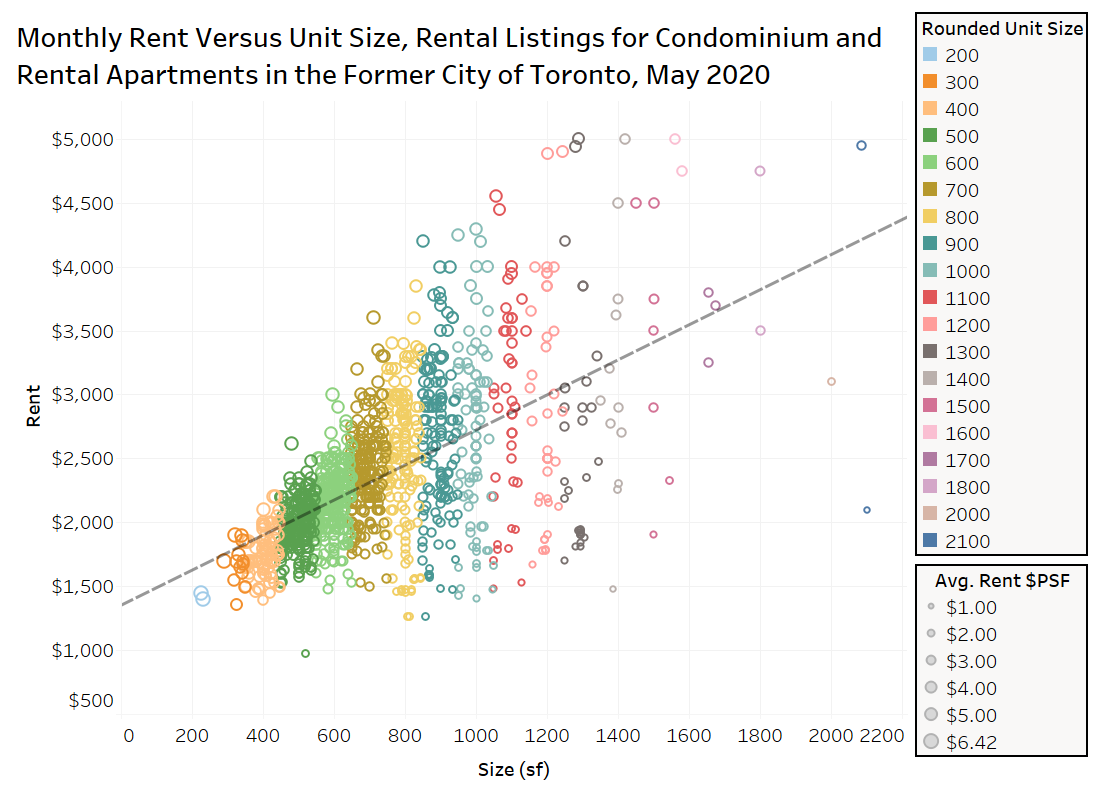Greater Toronto Area
As the COVID-19 pandemic continues to impact housing decisions, it is clear that tenants are starting to research properties again. The chart below shows the number of pageviews by postal code in the central GTA area for rental listings on Torontorentals.com in April and May 2020, with the monthly percent change in pageviews shown for May.
M5V is the most popular code in the GTA, and pageviews increased by 20% month-over-month. In M5A, the second most popular postal code by total pageviews, there was an increase in online activity of 29% in May over April.
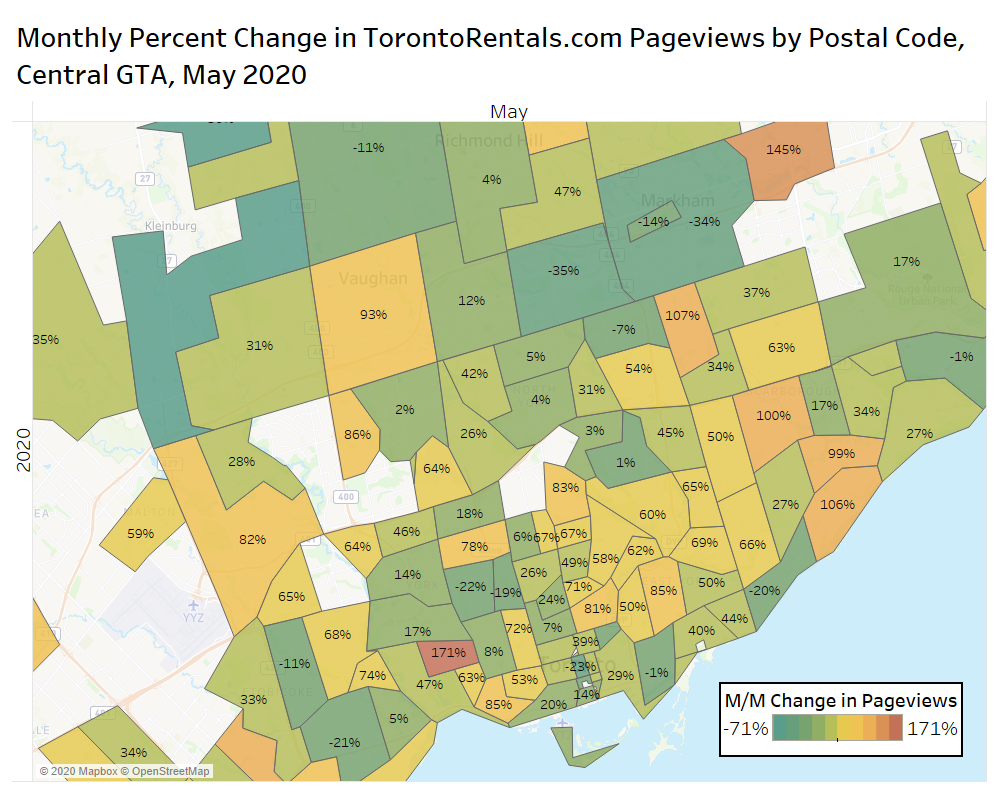
Average Rental Rates by Area
The chart below looks at the average rent for all property types (singles, semis, row, condo apartment, rental apartment, basement apartment) by municipality and former municipality in the GTA over the past 13 months.
The top 14 municipalities (and former municipalities using pre-amalgamation boundaries), all experienced a decline in average rental rates in the GTA monthly in May. The former City of Toronto saw rents dip 0.3% month over month from $2,387 on average in April to $2,380 in May, following a more steep drop of 3.9% the month prior.
On an annual basis, there are still a few areas that are up year-over-year in terms of average rents, Brampton is up 3.5%, Richmond Hill is up 2.8% and Milton is up 0.3%. On the flip side, average rents have declined by 6% to 10% annually in North York, Markham, Mississauga, York, Oakville, and East York.
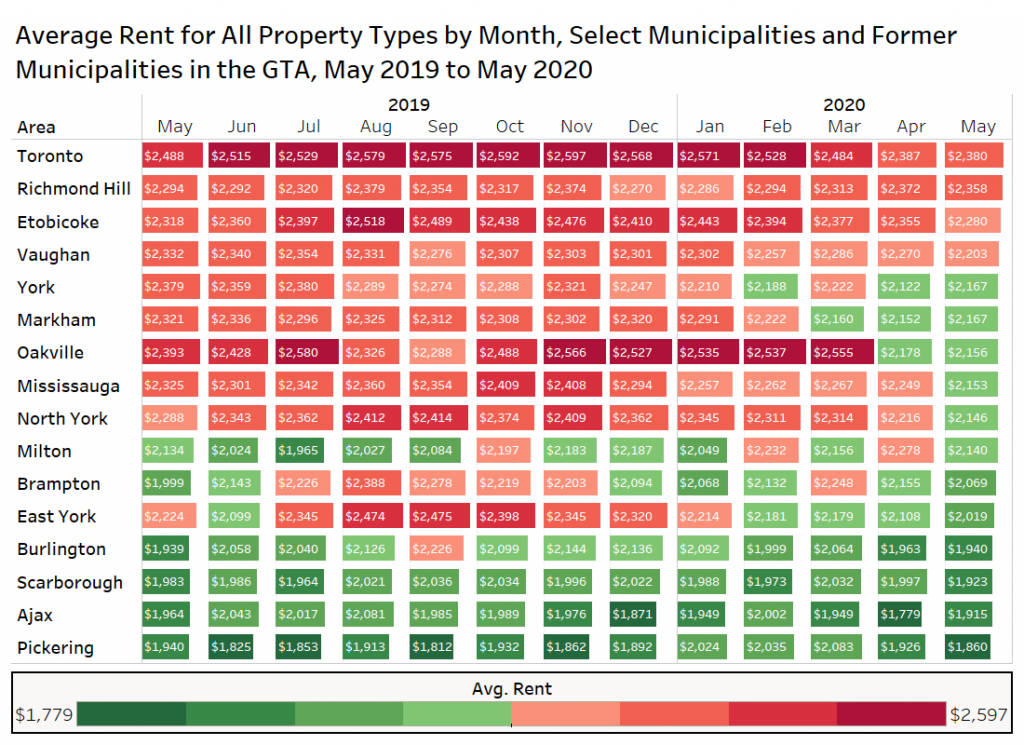
New Rental Apartments in the Toronto CMA
According to data from CMHC, there were 9,549 rental apartments under construction in the Toronto CMA at the end of May. As the chart below shows, rental apartments under construction have generally been trending up for the last 20 years (orange line).
In terms of rental apartment completions (blue area), there were 1,444 in July of 2019, more than any year from 1997 to 2007. There were 3,372 total completions last year, the most since 1993.
The slowdown in construction associated with COVID-19 has likely delayed the completion of at least a couple of rental apartments in the CMA this year, with 1,074 completed through the first five months of 2020 (there were 852 completions in February and 140 in May).
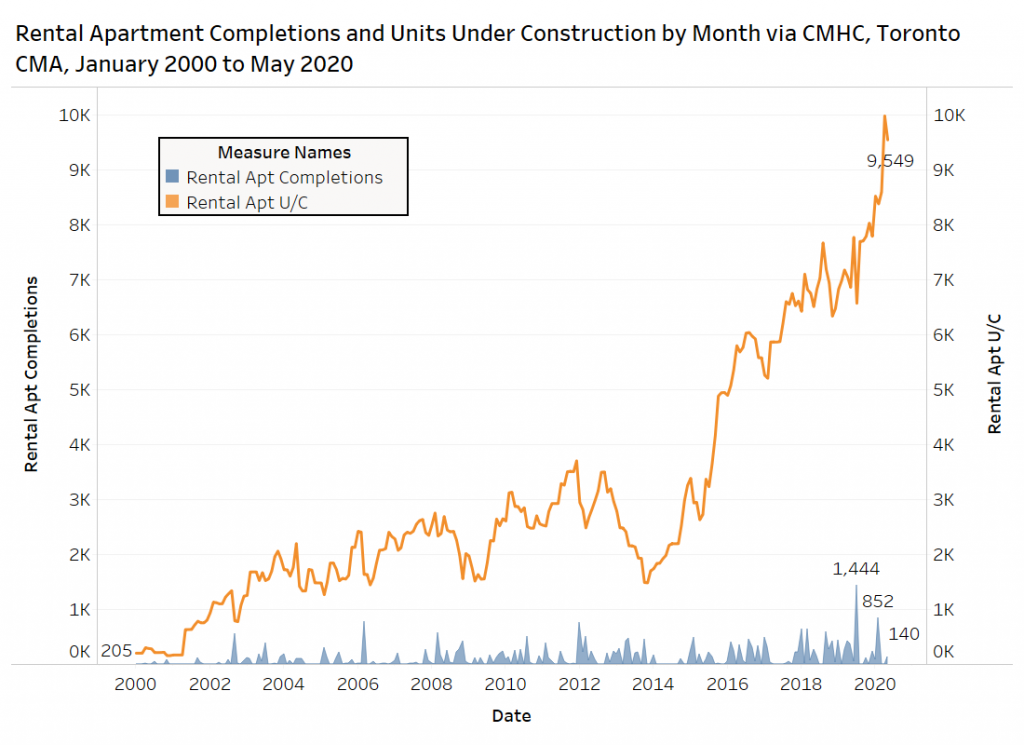
Rental Rates at Recently Completed Purpose-Built Rental Apartments in the Toronto CMA
A number of relatively new rental apartments have units listed on Torontorentals.com. The chart below lists a selection of those projects with their average 2019 rent, versus their average year-to-date rent this year.
The average rental rates in 2020 range from a low of $1,809 per month for 561 Sherbourne, a 43-storey tower with 429 units that completed in 2017 (just south of Bloor), to $3,833 for V6 Leslieville, a 6-storey development at 1602 Queen Street East that was completed in early 2020.
Average rental rates have decreased in 13 of the 18 projects with data available in both 2019 and 2020.
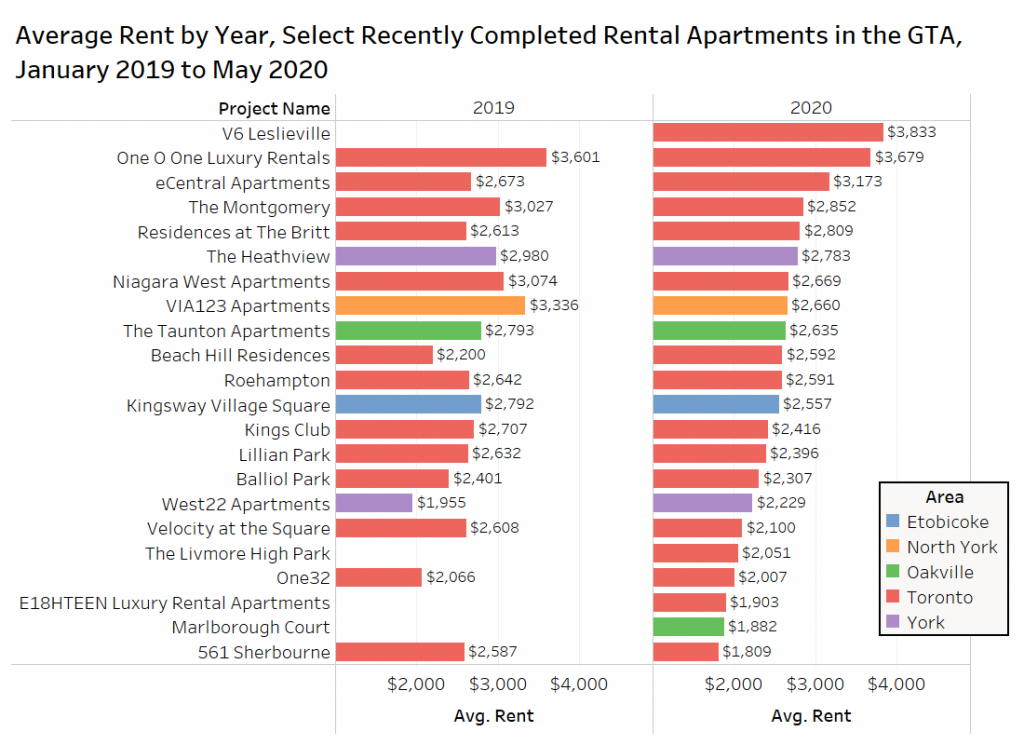
Rental Rates at New Apartments versus Leased Condos
How do rental rates at these new purpose-built rental apartments compare with rental rates at recently completed condo projects?
The chart below shows the average monthly asking rent and rent per-square-foot for these 22 newer rental apartments in 2020 versus the average rental rates for condominium apartments completed over the past ten years in the same five municipalities and former municipalities (Etobicoke, North York, York, Toronto and Oakville).
On average, it is more expensive to lease a new studio, one bedroom and three bedroom condo than a new purpose-built rental apartment. However, there is a much higher concentration of new condos in downtown Toronto, in comparison to the purpose-built sample. Secondly, many of the purpose-built rental apartments charge separately for parking, while many of the private condo landlords include parking (if one is available) in their asking rents – some buildings are charging as much as $150 to $175 per month extra for parking.
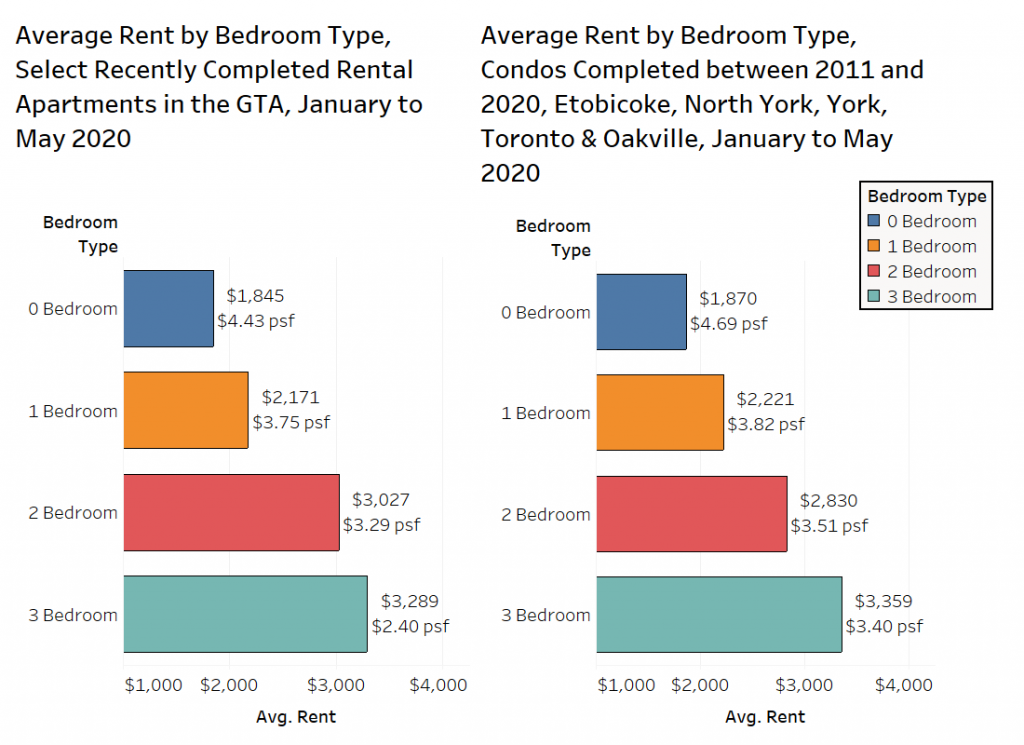
Rental Rates for Furnished and Unfurnished Units
There has been much discussion regarding the short-term rental market, as tourism in the GTA has all but stopped, and employment that attracts shorter-term contract work has been put on hold. The suites were also being rented to host parties and events, and those are not happening either.
Much of that short-term rental supply is furnished, and the chart below looks at the rental rate per-square-foot for furnished condominium apartments in North York, Etobicoke and Toronto in April and May.
Strangely, the average rent for furnished condos declined in all three areas month over month, but the average rent per-square-foot increased in all three markets. In Etobicoke and North York, the average size of furnished units declined significantly, suggesting that larger furnished units are either leasing or being pulled from the market.
Both Etobicoke and North York had fewer furnished listings in May in comparison to to April, while the former City of Toronto increased by 8.7%.
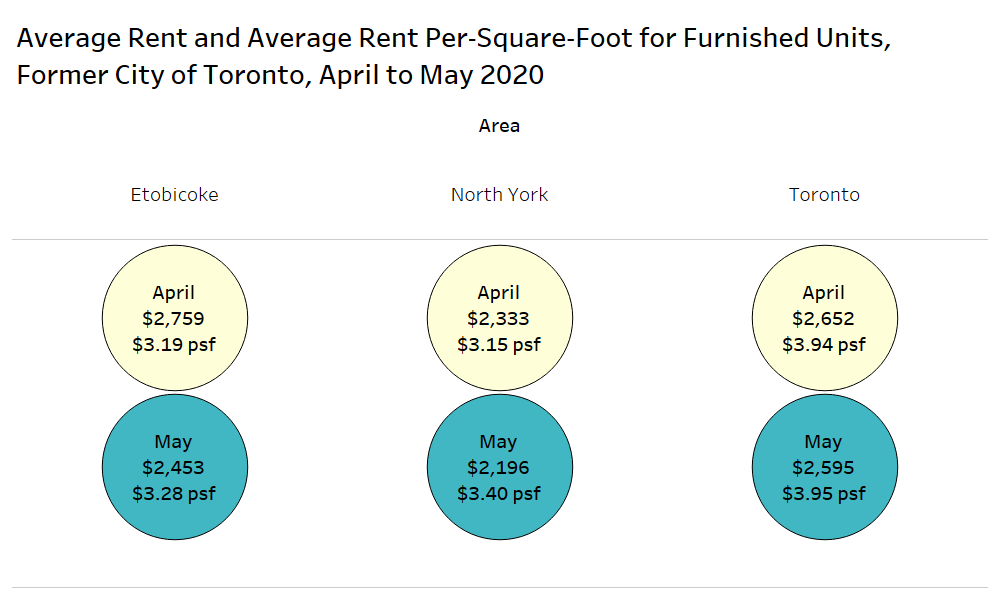
How Much Does One Additional Square Foot Cost?
One of the most common tenants complaints about living in a rental or condo apartment in Toronto is a lack of space. If you’re in the market for a larger suite, how much will each additional square foot cost you?
The chart below plots all of the condo and rental apartment listings on Torontorentals.com in May that had unit sizes available versus their asking rent. The grey dashed line is a linear trendline, which is used to try to best represent what a tenant would get at any combination or rent and unit size. The relationship is not totally linear, as the trendline intersects zero at $1,351, and no one is going to pay $1,351 dollars for an apartment with no square footage!
The trendline does show that a tenant will have to pay about $1.37 more for each additional square foot in Toronto on average.
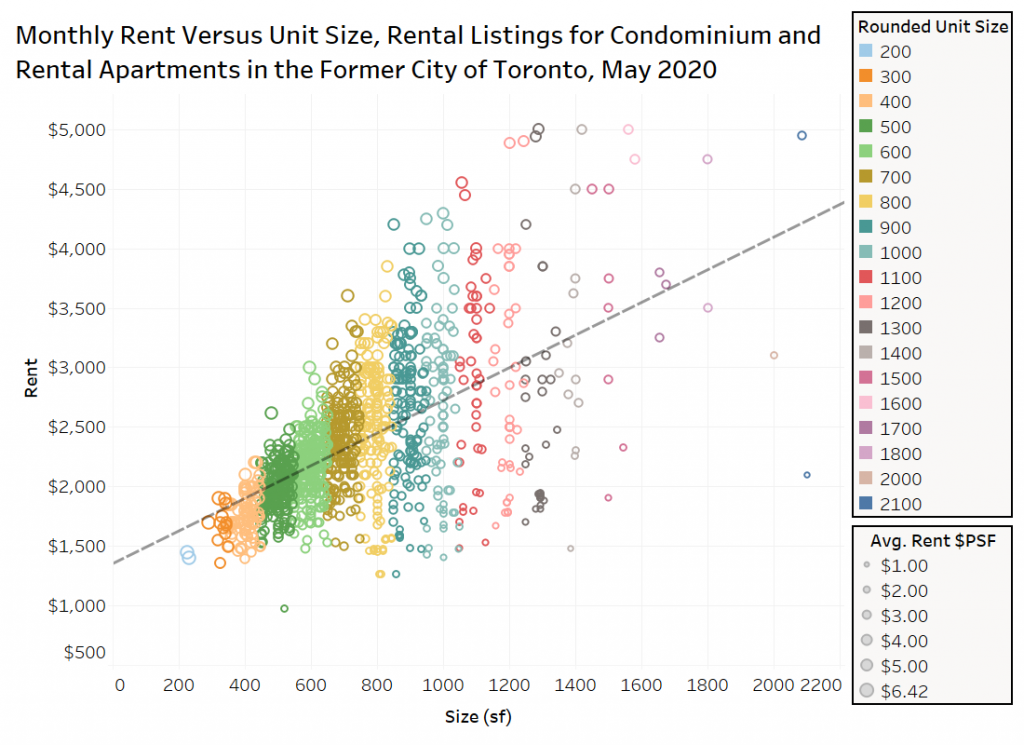
Conclusion
The rental market in the Greater Toronto Area was relatively soft in May, with most of the municipalities and former municipalities seeing average rents decline. There is evidence that tenants are looking at apartments online and doing their research, however, demand is still weak as health risks trump current rental rate declines, and there are fewer people moving right now.
The influx of short-term rentals into the full-time rental market due to the lack of tourism resulting from the COVID-19 travel bans, has caused an unexpected surge in supply, especially in prime investor-heavy downtown condo projects. The pandemic health concerns, coupled with reduced employment and hiring activity, has resulted in less immigration and reduced in-migration into the GTA. These consequences of the pandemic have significantly reduced rental demand at the same time as supply is increasing via short-term rentals and high-rise apartment completions.
Many of the new rental apartments featured above had no trouble leasing up when they were completed, with one of the projects on the list above leasing over 300 units in a single year. But even these highly desirable new projects with all the bells and whistles, security of tenure, and professional property management have been forced to lower rents and offer incentives like a free month’s rent in 2020.
Recent changes to the mortgage insurance rules by CMHC may reduce ownership demand, and keep some prospective buyers from purchasing their first home, but lower interest rates may offset that impact, especially given that Genworth and Canada Guaranty, the other major mortgage insurers have not made similar moves.
The market for single-family resale properties has really started to pick up, and despite low sales activity, the average price of a condominium apartment in the GTA increased by 8.2% monthly in May from $578,283 to $625,445. If the resale condo market continues to show strength, many condo investors will sell their units instead of renting them at levels well below their previous tenant. This will reduce the supply of rental units, which could stabilize rents in Toronto.
There remains an eviction ban in Ontario, and when that ban is lifted, there could be another wave of supply hitting the market as landlords look to remove delinquent tenants, while others choose to leave voluntarily due to financial hardship. The economic consequences of the pandemic have hit tenants harder than owners, with employment losses in services, retail and manufacturing. As the economy opens back up, many of those jobs will not come back and those tenants will be looking for smaller, cheaper suites, creating upward rent pressure at the very bottom of the rental market.
It is too early to call the bottom of the GTA rental market, but a recent study by Ryerson Centre for Urban Research and Land Development showed that the Toronto CMA is the fastest growing metropolitan area in the United States and Canada, and the City of Toronto remains the fastest growing central city based on 2019 population statistics.
It is likely that there is significant latent rental demand from adults living with their parents, 30-somethings living with roommates, and retirees looking to downsize to an urban apartment. Rental rates may not fall further, because demand for rental accommodation is expected to pick up as the lockdown ends, recent graduates start their careers, people cooped up with family or roommates look for their own place, and the border opens up to foreign students, temporary residents, contract workers, and immigrants.
We will continue to monitor the market and report on it here.
